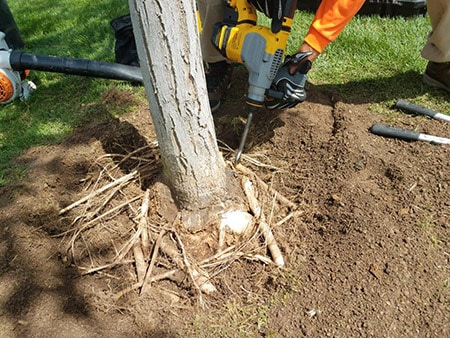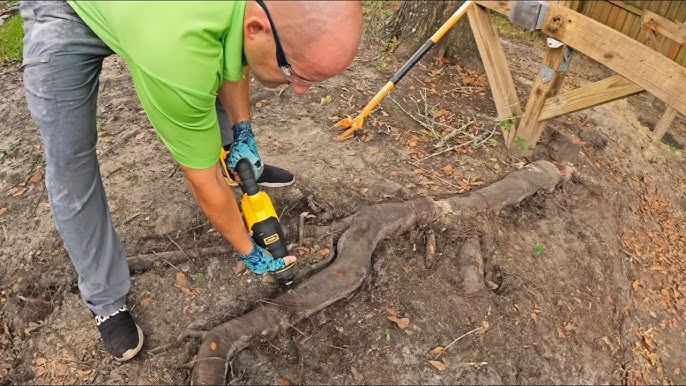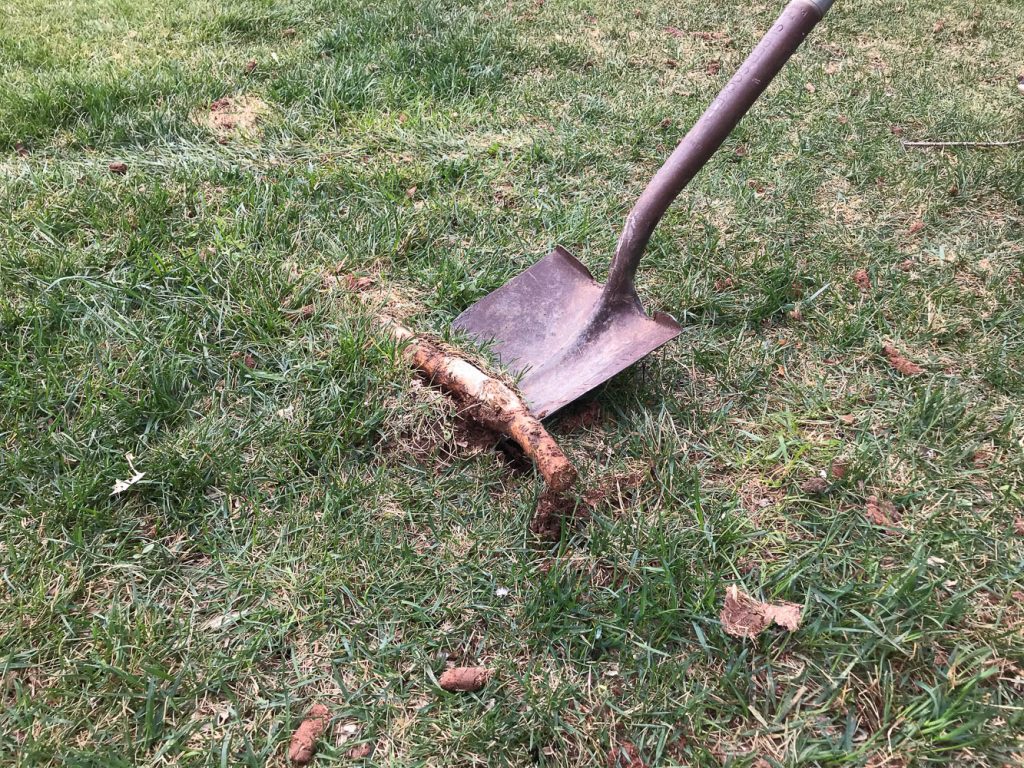Many homeowners like to keep their lawns immaculate, but invasive tree roots might occasionally interfere with this goal. Allowing tree roots to spread can create uneven surfaces, damage irrigation systems, and even pose safety risks to your lawn. Don’t worry; we’ll explore the nuances of remove tree roots from lawns on treeservicewestuniversity. With the right strategy and methods, you can recover your outdoor haven and restore the vitality of your grass.
Understanding tree roots and lawn damage
Tree roots have an important role in supplying stability and nutrients to trees, but when they spread into the lawn, they can cause substantial damage. Understanding the relationship between tree roots and lawn damage is critical to good management.

Roots compete with grass for vital resources such as water and nutrients, resulting in limited grass cover and uneven terrain. Furthermore, when roots grow and expand, they can alter soil structure, making it difficult for grass to create deep roots.
Recognizing the indicators of tree root invasion is the first step toward repairing lawn damage. Uneven surfaces, limited grass growth, exposed roots, and water drainage challenges are all indicators of potential root problems.
Understanding the behavior of tree roots and their influence on the grass allows homeowners to execute targeted removal and preventative techniques. With careful care, it is possible to have healthy and vibrant grass while living with surrounding trees.
Tools for removing tree roots from lawns
- Shovel
- Pruning shears
- Saw
- Root grinders
- Trenchers
How to remove tree roots from a lawn
Assessment: Begin by determining the extent of root infiltration and the regions of damage in your grass.
Excavation: Use a shovel to carefully dig around the afflicted regions, exposing the tree roots.
Root Cutting: Using pruning shears or a saw, cut through the exposed roots, severing them entirely.
Removal: Remove the severed roots from the earth, taking care not to harm the surrounding plants.
Backfill: Fill the excavated sections with soil and gently push down to level the surface.
Grass Replacement: If necessary, transplant grass in treated areas to restore the lawn’s appearance.
Monitoring: Check the treated areas regularly for evidence of regrowth or new root intrusion, and take action as necessary.
To avoid further root intrusion, implement preventive measures such as root barriers or strategic tree planting.
How to remove tree roots from a lawn chemically
Assessment: Begin by locating the root intrusion sites and determining the degree of damage to your lawn.
Selecting a Chemical Treatment: Select an appropriate chemical treatment for root removal. Herbicides designed to control roots may be an option.
Preparation: Before using any chemical treatment, read and carefully follow the manufacturer’s instructions. To safeguard your safety, use appropriate clothing, gloves, and eyewear.
Application: Apply the chemical treatment directly to the afflicted grass sections where root infiltration is visible. To ensure uniform distribution of the chemical, use a sprayer or watering can.
Allowing Absorption: Allow the chemical treatment to soak into the soil and adequately reach the tree roots. Follow the recommended waiting time listed on the product packaging.
Monitoring: Regularly, inspect the treated areas for signs of root damage and degeneration. Depending on the degree of the root invasion, multiple treatments may be required.
Disposal: Always dispose of any unwanted chemical products and empty containers according to local rules and recommendations.
Chemicals used for root removal:
Herbicides containing glyphosate
Triclopyr-based insecticides.
Potassium nitrate (saltpeter).
Copper sulphate

When applying chemical treatments, always proceed with caution, taking into account the potential environmental impact and safety precautions. If you’re unsure, seek advice from a professional arborist or landscaper.
The Best Time to Remove Tree Roots from the Lawn
The best time to remove tree roots from your lawn is during the dormant season, which often occurs in late fall or early winter. During this time, trees are less active, making it easier to detect and remove roots without putting the tree under undue stress. Furthermore, cooler temperatures and lower moisture levels in the soil might reduce the likelihood of soil compaction and damage to nearby vegetation.
Avoid doing root removal during active growth seasons, such as spring and summer, as this can disturb the tree’s normal processes and increase the possibility of regeneration. Timing root removal during the dormant season allows you to successfully treat root intrusion while minimizing negative effects on your lawn and trees.
The care and maintenance of tree roots in the lawn
Maintaining healthy tree roots is critical to the health of your grass and trees. Here are some suggestions for caring for and preserving tree roots in your yard:
Watering regularly is essential for promoting healthy growth and preventing dehydration.
Spread organic mulch at the base of trees to retain soil moisture, regulate soil temperature, and inhibit weed growth. This also helps to protect the roots from lawnmowers and foot traffic.
To avoid overcrowding and nutrient competition, prune tree roots regularly. To keep your root system healthy, remove any damaged or diseased roots.
Aerate the soil surrounding trees regularly to reduce compaction and promote root access to air, water, and nutrients.
Use a balanced fertilizer to offer the necessary nutrients for root development and general tree health. Follow the suggested criteria for application rates and timing.
Preventive Measures: Maintaining a Root-Free Lawn
Once you’ve successfully removed tree roots from your lawn, you must take preventive actions to avoid future occurrences. Here are some proactive activities you can take to keep your grass root-free:
Regular Maintenance: Monitor your grass closely for signs of root encroachment. To prevent conflicts from escalating, address them as soon as they arise.
Root Barrier Installation: Physical barriers, such as root barriers or underground barriers, can help prevent tree roots from encroaching on lawns.
Strategic Tree Placement: When planting new trees or landscaping, keep in mind the proximity to existing lawn areas and choose tree species with noninvasive root systems.
FAQS
How long does it take to get rid of tree roots from a lawn?
The size of the root system, the method of removal, and the extent of the damage all affect how long it takes to remove tree roots from a lawn. Sometimes, one can accomplish root removal in a few hours, but more substantial projects may require several days.
Can tree roots regrow after removal?
While tree roots can regenerate in some cases, proper removal techniques can dramatically reduce regrowth. However, regular maintenance and monitoring may be required to avoid new root growth and guarantee your lawn’s long-term health.
Is it okay to use chemical treatments for root removal?
When used according to product directions and safety standards, chemical root removal procedures can be effective and reasonably safe. However, it is critical to exercise caution and evaluate the potential environmental repercussions. Consulting with a professional arborist or landscaper can help you choose the best approach for your scenario.
How deep do tree roots generally grow?
The depth of tree roots varies according to species, soil conditions, and environmental influences. Tree roots can extend from a few inches to several feet below ground level, with deeper roots providing support and access to water and nutrients.
Can I transplant grass once I’ve removed the tree roots?
Yes, once the tree roots have been effectively removed, you can replace the grass to rejuvenate the lawn’s beauty and health. To ensure effective establishment, prepare the soil properly and select grass species that are appropriate for your climate and soil conditions.
Conclusion
Keeping a lush and healthy lawn takes proactive management, particularly when dealing with invading tree roots. Understanding the underlying causes of root intrusion and applying effective removal and preventive techniques can ensure that your grass remains vibrant and resilient for many years. Remember that the key to successful root removal is careful planning, good technique, and continuing maintenance. Whether you handle the chore yourself or hire specialists, improving the health of your lawn will result in a more pleasurable outdoor space for you and your family.

